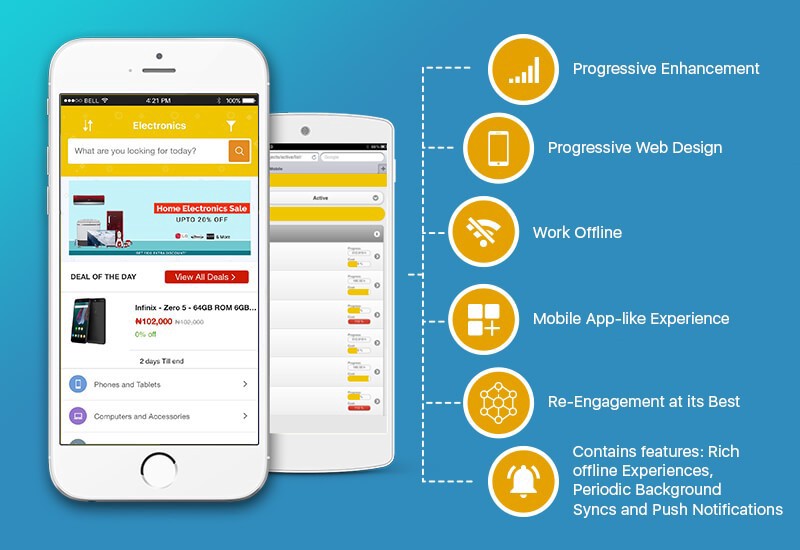The world of mobile app development has definitely changed in the past couple of years. There has been a significant and rising usage of complicated programming languages, libraries and frameworks which have evolved the matter from a simple “build an app which does something” to “build an architecture which could do this and also that”. Examples like machine learning, deep learning and automatic learning applications have almost become an industry standard within the mobile development app sector. On top of this, there have been a lot of companies who tried to apply several modern features, one of these being progressive web features. Let’s analyse why Google’s model is the most successful one and how it will reshape the industry.
What’s The Definition Of “Progressive Web App”?
By “PWA” we refer to an application which features can be used both from desktop and mobile. Example like Instagram, Facebook and Whatsapp are the biggest ones, but this is becoming quite a trend especially with React – heavy applications like Tinder and VSCO. Of course, the fact that an app is usable both from desktop and mobile doesn’t automatically make it “progressive”. Overall, the traits which describe a PWA are:
- Responsiveness;
- Simple UI (mainly because the vast majority of these apps are React-based);
- Speed;
- Light (it’s very rare to find a PWA which surpasses 200 Mb).

The Importance of Server-Ready Content
The main difference between normal web applications and progressive web applications is the fact that for the vast majority they are server-ready. Per definition, a server ready application is an app which renders and gathers all (or the biggest part of) its content from a dedicated server. With the advent of AWS, this has become quite a common practice, especially within those applications who are very image-driven: the usage of server-ready features drastically improves speed, mainly because it reduces the number of server requests (effectively, just one). Being server-ready is the first step when it comes to developing a solid and powerful progressive web application. On top of this, the usage of server-ready features could also help when combined with data lake and data warehousing-related features, which are becoming very common in the mobile app development world, even for small projects. This, though, has to be monitored given the recent changes (with GDPR, especially) in data acquisition policies. After the Cambridge Analytica scandal, in fact, the usage of data, in particular on mobile devices, has become very strict when applied to marketing-related features.
Serving Franchise Applications
Let’s introduce Google’s winning PWA model. Google builds REST-ready applications which are then deployed into other ones. For example, Google Maps’ API is used thoroughly on the web in several “where to find us” pages. Not only this is made possible due to the REST-based design of the app, but also because of the fact that, in fact, it is a progressive web app. The usage of progressive web applications from Google’s side is, in fact, merely relying on being able to deploy several features to several applications: Maps is used in Search, Search is used in Maps and so on. This “network” is made possible because of the server-ready nature of these apps and because of the fact that Google’s very own approach to progressive web applications has taken communication into place, massively.
This very approach has been used by Amazon as well, but more from an architectural point of view: Node-built servers, when applied to AWS data warehousing features, have become the leitmotif of Bezos’ mobile world. AWS is the home of many PWA and it will definitely become even bigger in the next few years.

Google PWA: What Are The Differences?
Google has said multiple times how the usage of progressive web applications will become its main focus in the next few years. As mentioned above, the fact that Google flagship applications communicate between each other via REST protocol would be enough to separate the search titan from its competitors but, in regards to the building-side of things, we can say that Google PWA differ because:
- they are Node and React built (exclusively);
- do not support certain files (bulky ones, to keep them light and fast);
- are search injected (they are rendered and indexed within search engines, generating featured results).
The last point, in particular, has been mentioned by multiple analysts, who said that the fact that Google is building apps for search-related purposes is merely the start and the acknowledgement of a new ranking factor. Are progressive web applications going to be ranked as organic results within search in the nearest future? Only time will tell, but, for now, it is a possibility which we shouldn’t exclude.
Progressive Web Applications Aren’t Remote Controlled Desktop Apps
Given the fact that the biggest PWA are Google Maps, Whatsapp Web and Tinder, many started to define progressive web applications as mere remotely controlled desktop apps, but this is far from the truth. We’ve covered above how cross-platform (mobile to desktop and vice-versa) communications are a stable variable within progressive web applications, but this isn’t the only known feature within those architectures. For example, the usage of data lakes internally, combined with its automatic rendering, has become a stable constant within their development route. Overall, it’s safe to say that progressive web applications have integrated a number of pieces of technology which are renowned for being extremely competitive in today’s market.
The Market Value
In regards to PWA, whether if Google-based or not, it’s important to assess how their deployment in today’s tech market has been perceived. We’ve mentioned above how Amazon has heavily valued them for their mobile portal, but there are tons of other tech giants who have been using PWA/Server-ready applications. TESLA, for example, has used a PWA feature within their brand new “summon” feature: the app constantly communicates with the head computer, effectively becoming its “mobile version”. In this case, what differs from “normal” PWA, is the fact that once activated, the app utilises the device’s very own hardware to establish where the driver is placed, the surroundings and, therefore, by cross-referencing this data with the head computer, it’s able to create a safe route for the car to automatically reach its driver.
Costs In Development
PWA-development routes have been included in a variety of project recently. Companies are seeing constant communication between mobile and desktop for an app as something (almost) mandatory, as it is something which will drastically help both the UX and the functionalities of the architecture. Developing a PWA version of a mobile app isn’t complicated, especially if it’s heavily relying on Swift, React and other components-based programming languages. Costs-wise, PWA versions of enterprise-level apps are offered as a “package extension” for now. Given how big the subject is, we can safely say that this is going to be offered to clients as a separate feature for projects, especially within the online messaging micro world (following WhatsApp’s model). Picturing precise costs in regards to these applications is relatively hard for now, but it will definitely become more expensive given the fact that a lot of complex features (i.e. rendering, 3d modelling and such) are being deployed and researched into PWA architectures.

Is This, Therefore, The Future Of Mobile App Development?
Google PWA and PWA in general for mobile app development are definitely something which will grow as a subject and as a piece of overall technology in the nearest future. Mainly because of the fact that they are very data-friendly, therefore successfully deployable within a number of marketing-oriented applications (ranging from eCommerce to lead generation), the potential of PWA is relatively infinite given how the mobile app development is evolving. This (as said above) should be acknowledged in regards to the recent data acquisition-related policies which have been set into place from the EU (and with the recent net neutrality law introduced by the FCC in the US). With all these factors in mind, we can definitely say that PWA-oriented architectures are most likely set to become a stable future in mobile app development.
To Conclude
The world of mobile app development is moving at the speed of light. With dozens and dozens of new creative and technical ways to run/develop and grow an application, this is definitely set to become one of the biggest trends within the industry. We can also safely expect to see a variety of “build it yourself” tools being launched soon, merely for the above-mentioned desktop-mobile communication. Overall, the usage of PWA features within the world of mobile app development will definitely be remembered as the pivotal point for user transferability.
Content
- 1 What’s The Definition Of “Progressive Web App”?
- 2 The Importance of Server-Ready Content
- 3 Serving Franchise Applications
- 4 Google PWA: What Are The Differences?
- 5 Progressive Web Applications Aren’t Remote Controlled Desktop Apps
- 6 The Market Value
- 7 Costs In Development
- 8 Is This, Therefore, The Future Of Mobile App Development?
- 9 To Conclude
